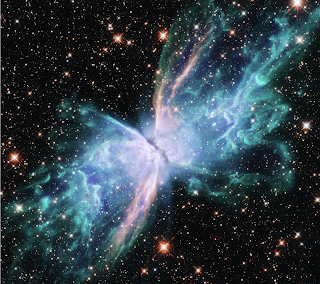Stars Gone Haywire.
The Butterfly Nebula
Imagine a lawn sprinkler spinning wildly, tossing out two S-shaped streams. At first it appears chaotic, but if you stare for a while, you can trace its patterns. The same S-shape is present in the Butterfly Nebula, except in this case it is not water in the air, but gas blown out at high speed by a star.
The S-shape directly traces the most recent ejections from the central region, since the collisions within the nebula are particularly violent in these specific regions of NGC 6302. "This iron emission is a sensitive tracer of energetic collisions between slower winds and fast winds from the stars. It's commonly observed in supernova remnants and active galactic nuclei, and outflowing jets from newborn stars, but is very rarely seen in planetary nebulas.
 |
| The Butterfly Nebula |

Comments
Post a Comment